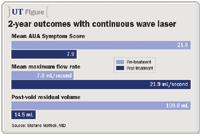Article
New laser for BPH found effective, safe at 2 years
A new continuous wave thulium laser device appears to offer a safe, bloodless, effective, and expeditious outpatient surgical procedure for men with BPH.

Key Points
Berlin-A new continuous wave thulium laser device appears to offer a safe, bloodless, effective, and expeditious outpatient surgical procedure for men with BPH, according to a recent study from Italy. The study's author adds that the procedure using the RevoLix 2 (Healthtronics, Austin, TX) is easy to perform.

Dr. Mattioli conducted a 2-year study on 120 patients with BPH using the RevoLix 2 micron continuous wave laser. The FDA-approved device has a wavelength of 2.013 microns and is used at 70 watts with front- and side-firing fibers.
Patients in the study ranged in age from 45 to 87 years. Ten patients presented with urinary retention (two with acute retention) and nine patients were receiving anticoagulant therapy. PSA, transrectal ultrasound, biopsies (if indicated), AUA Symptom Score (AUA-SS), maximum flow rate (Qmax), and post-void residual volume (PVR) measurements were performed. Patients were divided into two groups on the basis of the size of their prostate, which ranged from 20 to 80 grams. The first group (85 patients) was designated for vaporization of the prostate (<35 grams) using side-firing arms; the second group (35 patients) was designated for transurethral vaporesection of the prostate (<80 grams) using bare-ended, front-firing fibers. Dr. Mattioli noted that these treatments can be administered in tandem.
Treatment time ranged from 15 minutes for 20-gram prostates to 60 minutes for prostates of 80 grams or less. According to Dr. Mattioli, the speed of the procedure in the vaporization group was the same as with the potassium-titanyl-phosphate (KTP) laser, but in the vaporesection group, the RevoLix was quicker than KTP device on the larger glands.

Following thulium laser treatment, mean AUA Symptom Score decreased from 21.9 to 7.9, mean Qmax rose from 7.6 to 21.9 mL/second, and PVR decreased from 109.8 to 14.5 mL: outcomes comparable to those of transurethral resection of the prostate and KTP vaporization.
Re-treatment with RevoLix was performed in three patients due to insufficient vaporization of prostatic tissue in the first treatment. None of the patients required additional treatments, such as bladder neck incision or urethral stricture correction, and none required blood transfusions following the procedure.
"The depth of the penetration of the laser is approximately 1 to 2 mm, and in 1 minute, you can vaporize approximately 2 grams of tissue," Dr. Mattioli said.
Distinct advantages seen
Advantages of the thulium device are that patients on anticoagulant therapy can be treated without risk, hemostasis is comparable to that of KTP laser treatment, and vaporization and vaporesection can be performed under any anesthesia.

Navigating work-life balance: VUMC’s Family Planning for Surgeons Series

Investigators identify potential dual targets in prostate cancer



